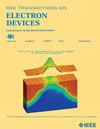Ferroelectric Assisted Programmable Carrier Stored Layer for Ultralow Turn-Off Loss LIGBTs
IF 2.9
2区 工程技术
Q2 ENGINEERING, ELECTRICAL & ELECTRONIC
引用次数: 0
Abstract
This work represents the first exploration of ferroelectric HfZrO (HZO) in lateral insulated gate bipolar transistors (LIGBTs), introducing a novel approach to reduce turn-off loss by incorporating a separate ferroelectric control electrode on the carrier stored layer (CSL). Utilizing the unique properties of ferroelectric HZO, such as its non-volatile nature and strong polarization field, the proposed Fe-controlled CSL enables dynamic modulation of carrier concentration in the LIGBT structure. This novel design demonstrates a remarkable 73.6% and 64.9% reduction in turn-off loss (用于超低关断损耗灯的铁电辅助可编程载波存储层
这项工作代表了铁电HfZrO (HZO)在横向绝缘栅双极晶体管(lightts)中的首次探索,引入了一种通过在载流子存储层(CSL)上结合单独的铁电控制电极来降低关断损耗的新方法。利用铁电HZO的独特性质,如其非挥发性和强极化场,所提出的fe控制CSL可以动态调制light结构中的载流子浓度。在保持相同导通电压(${V} _{\text {on}}$)的情况下,与传统的CSL light和短路阳极light相比,这种新颖的设计分别降低了73.6%和64.9%的关断损耗(${E} _{\text {off}}$)。HZO材料的综合表征证实了其优异的铁电性能,包括高残余极化,卓越的耐久性和强大的数据保留能力。通过对载流子浓度分布的仿真分析,揭示了fe控制CSL调制对载流子分布的影响机制。这种创新的fe控制CSL技术为克服传统light器件的导通和关断特性之间的权衡提供了新的途径,为高性能功率器件的发展铺平了道路,在需要高功率密度集成的领域具有很大的应用前景。
本文章由计算机程序翻译,如有差异,请以英文原文为准。
求助全文
约1分钟内获得全文
求助全文
来源期刊

IEEE Transactions on Electron Devices
工程技术-工程:电子与电气
CiteScore
5.80
自引率
16.10%
发文量
937
审稿时长
3.8 months
期刊介绍:
IEEE Transactions on Electron Devices publishes original and significant contributions relating to the theory, modeling, design, performance and reliability of electron and ion integrated circuit devices and interconnects, involving insulators, metals, organic materials, micro-plasmas, semiconductors, quantum-effect structures, vacuum devices, and emerging materials with applications in bioelectronics, biomedical electronics, computation, communications, displays, microelectromechanics, imaging, micro-actuators, nanoelectronics, optoelectronics, photovoltaics, power ICs and micro-sensors. Tutorial and review papers on these subjects are also published and occasional special issues appear to present a collection of papers which treat particular areas in more depth and breadth.
 求助内容:
求助内容: 应助结果提醒方式:
应助结果提醒方式:


